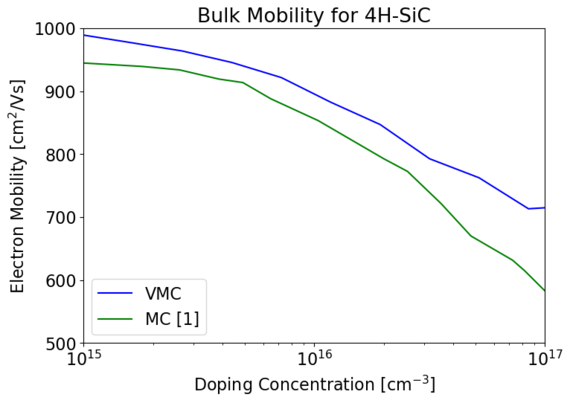 |
|
||||
BiographyMarkus Kampl was born in Vienna, Austria, in 1988. He studied electrical engineering at the TU Wien, where he joined the Institute for Microelectronics in October 2012. He received the degree of Diplomingenieur and the PhD in November 2015, respectively April 2019. Currently, Markus is a Postdoctoral researcher in the CDL for Single-Defect Spectroscopy and his work focuses on developing a simulation framework to calculate the carrier mobility in power MOSFETs. |
|||||
Simulation of Carrier Mobility in 4H-SiC Bulk Material
After finishing my PhD this year, I joined the Christian Doppler Laboratory for Single-Defect Spectroscopy in Semiconductor Devices, where I started to investigate measurement systems and characterization methods suitable for defect spectroscopy in SiC devices. Also, a particular focus of my work has been on the explanation of measurement data using results from simulations employing the drift-diffusion model, which have been carried out using MinimosNT. In addition to complex device simulations, I also performed simulations of the impact of defects on device behavior using our reliability simulator, Comphy. Furthermore, improvement of the semi-automated measurement systems used to collect data for the calibration of device simulations has been a part of my efforts.
As said before, drift-diffusion simulations have been performed in order to explain recorded experimental data from lateral and vertical SiC metal-oxide-semiconductor (MOS) transistors. For this, the parameters of the employed models (band structure, mobility, etc.) have been adjusted accordingly. It turns out, however, that the description of the behavior of the SiC MOS devices is more complex as compared to Si transistors. An essential parameter in that regard is the mobility of the carriers, for which no suitable model is yet available. Based on my recent efforts in developing methods for Monte Carlo (MC) simulations, we decided to make use of the MC method, in combination with parameters calculated from ab-initio methods, like the full band structure and various scattering mechanisms, in order to use this established method for non-silicon materials, too.
For this, our MC simulator, called Vienna Monte Carlo (VMC), which was initially developed to investigate the trajectory of carriers in Si devices, was extended to be able to calculate bulk mobility for materials exhibiting a non-cubic lattice. As 4H-SiC is at the moment the most relevant polytype, we developed MC simulations around that. We started to adjust the band structure of the 4H-SiC material in our MC simulator. The band structure exhibits two local band minima, which are very close to each other. To approximate the band structure, a parabolic band approximation is typically used for Si. For SiC, however, there are several publications that strongly suggest such simple parabolic band approximations are not appropriate, but instead encourage consideration of an analytic multi-valley band approximation. Using the full electronic band structure would be even more accurate. As the implementation of the full band structure requires a similar degree of effort to that of an analytic multi-valley band approximation, the former has been chosen for our future simulations for SiC. Thus, the full band structure has been calculated using density functional theory. Following this, VMC has to be extended to wurtzite-lattices as a possible source for band structures. Also, the available scattering models from Si have been adjusted for SiC with values found in the relevant literature [1]. It has to be noted that for SiC, polar-optical phonon scattering has to be considered. For this, I added an additional scattering contribution.
Finally, following the implementation of these advancements, the bulk mobility from 4H-SiC can be reproduced using our MC simulations for quite a low impurity concentration (see Fig. 1). These developments will pave the way for investigating the bulk mobility of 4H-SiC in the regime of technologically relevant doping concentrations and profiles.
[1] J. Wozny et al., CSC, 2018.
Fig. 1: Comparison of the electron mobility of bulk 4H-SiC calculated using a VMC simulation to data from [1]. Considering the early stage of my investigations, the mobility trend can already be reproduced nicely.


